Epic Restoration Discovered in the remains of a shed on a Welsh hillside via Ordnance Survey map grid co-ordinates, this pre-production prototype Aston DB4 restoration tested the abilities of some of the best in the business.
Someone told me that they’d seen an Aston Martin in a shed on a hillside in Wales – it was a rumour among the locals,’ says long-term marque specialist and restorer Roger Bennington. It sounds more like the opening lines of a myth that led to the discovery of a Bronze-age Celtic hoard, rather than a classic-car barn-find, but serial collector and restorer Bennington couldn’t resist investigating it further. In 2006 he sent one of his Stratton Motor Company colleagues to check it out, and he came back with news of a very early DB4, and an Ordnance Survey grid reference – 50 22 21 21 – rather than a postcode.
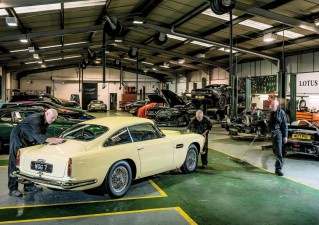
‘Its owner, Nevill Albert Rees, bought it slightly damaged in 1962, did it up, then he and his wife used it as a runabout until 1982, when it dropped a valve and developed a misfire. Intending to fix it one day, he pushed it into a corrugated tin cow shed on his farm, where it stood, protected only by a pile of rubbish on top of it, for nearly 25 years. There wasn’t even a door on the cow shed, there was no insulation, the wind blew straight through it, and the cattle would go and stand in there when it rained.
‘When we found the car, it had a vinyl roof that had been fitted in the Seventies, and a tow bar – Rees had used it to pull his caravan. In his ownership it had changed colour several times. It had been maroon, then blue – he’d change its colour on a whim in the space of an afternoon. It wore lime-green Sixties vinyl seat covers, but it was clearly a very early car on account of its frameless doors and rear-hinged bonnet. But crucially, it was all-original underneath.
‘According to its chassis plate it was the tenth of a pre-production batch of 12 cars built in 1958. It was first registered in May 1959 to Callanders in Glasgow, which used it as a demonstrator before it was sold to John Richard Inshaw of Newton Mearns, Renfrewshire, on December 23. After a minor accident he sold it to Rees via Brooklands of Bond Street.
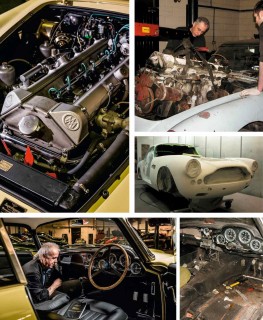
‘However,’ says Bennington, fishing out a 1958 DB4 brochure and a copy of Aston Martin’s factory records from the time, ‘we think that prior to all this it was used for promotional work as one of the very first cars to be completed. On the original build sheet this car is listed as its only non-standard equipment being fully chromed wire wheels, and finished in Primrose Yellow – the remnants of which could be seen in the door jambs. Only three of the first 12 were Primrose. The first off the line was incomplete, not even fitted with headlights, and registered to the David Brown Company which was usually a sign that it was a test car, given lots of stick and driven hard – often by Brown himself. The only other Primrose car was apparently left-hand drive with whitewall tyres, clearly built for the US market. Which points to this car being the one used on the launch brochure’s cover.
‘It’s difficult to know how many cars were made in 1958 – Aston used to list delivery dates rather than completion dates, and many of the early cars hung around the factory in a half-finished state until they were bought. The second right-hand-drive car in the country wasn’t registered until December 31, 1958, so all the data we could find pointed to this car being one of these prototypes, and one of if not the earliest surviving DB4 in the world. We had to save it.
‘Rees was reluctant to sell it at first – after all, he had intended to fix it up again – and it took a couple of visits to persuade him, but he sold it to us on the promise that we’d restore it rather than sell it. We stored it for five years, keeping it dry but just looking at it, wondering how on Earth we’d go about starting the restoration. People who came in to see it said we’d be mad to try, but given how important the car was, we had to. I promised Rees a drive in it once we’d finished, but sadly he died just before we completed it.’
Chassis and body horrors
‘Much of the body and chassis simply had to be cut out – it was just too far gone,’ Bennington sighs, ‘but to us it was important to use as much of the original bodywork as possible. Some of the Superleggera tubing was completely rotten through, but once the body’s off it’s actually quite easy to get to and work on – just cut out the old tubing and weld in new metal. Most of it could be reused, because it’s well-protected by the aluminium body, but the chassis was very bad. There was a hole in the boot floor so big that a couple of old golf balls had rolled out through it and got lodged inside one of the sills!
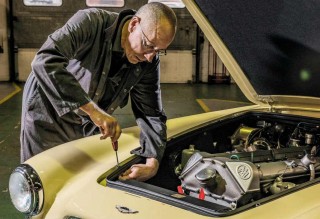
‘After shotblasting the chassis, we realised the floor wasn’t quite so bad as we’d feared, but it had gone terribly frilly around the wheels and front crossmembers. It needed new metal, but we don’t take the old bits out straight away, because for a bespoke car like an Aston Martin, they act as a guide when creating new chassis sections. Only once you’ve created the replacement section do you cut the old part out, so you only ever weld new metal to old metal. ‘In order to get the bodywork just right, I got Alan Pointer of Bodylines involved. He was an Aston Martin apprentice when he was a boy, and learnt his craft working on later DB4s.’ Bennington’s care in ensuring any rotten chassis sections were replicated before they were removed proved especially prescient in this DB4’s case, as Pointer explains. ‘Because it’s one of the earliest cars, it has an unusual chassis,’ he says. ‘It’s the only one I’ve seen with a removable panel in the boot floor so the exhaust pipes can be accessed from above. It would’ve been part of the prototyping process, playing with various different exhaust systems to see which one worked best. There were strange sections near the sills, running under the passenger- side seat, and also a pair of gussets underneath where the propshaft emerges. I suspect it was all done to strengthen the chassis – stiffness was a real concern with early DB4s, the Series I and II cars had overlapping box sections to create the floorpan.
‘The vinyl had actually protected the old roof by effectively sandwiching it. That probably saved it – it was slightly marked underneath but no worse than if it had been left out in the rain for a couple of years.
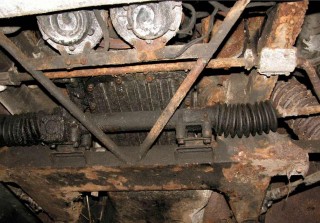
‘Unfortunately the same couldn’t be said for the rest of the bodywork, because corrosion was extensive. It wasn’t a complete basketcase – the rot was in all the usual places – but it was in every single usual place, and it was bad. Sills, floorpans, boot floor, around the engine bay – it was all rusty and needed replacing.
‘Bodywork-wise, we needed to remake the front and rear ends and re-skin the doors. Thankfully, despite being a pre-production car, its bodywork dimensions were the same as the production cars so it was fairly straightforward to create new panels around the existing bonnet and bootlid. It’s a good thing Roger kept it as it should be, because many of the early cars were modified in period and are still like that even today. Especially the bonnets, which were front- hinged soon after this early run.’
Karl Francis was tasked with returning the Aston to its original shade of Primrose Yellow. ‘He primered it, rubbed it down, primered it again, gave it a base coat then two coats of clear lacquer, then promptly left the business and gave it to me to finish off!’ laughs bodywork restorer Cliff Warner.
Lucky with the engine
Paul Bellenger was tasked with much of the car’s reassembly and also tackled the engine, but he had an unlikely stroke of luck. ‘There was a little bit of oil left in there from 1982 that had kept the internals from corroding,’ he says. ‘It was a real relief when it came to keeping everything as original as possible, and in the main it wasn’t too difficult to rebuild.

‘However, changing the cylinder liner seals was a tricky job – they’d seized themselves in there and they needed gently heating up in order to take out – always a risky task when there’s aluminium nearby. After we removed the liners, we soda-blasted the engine internals, and were able to re-use everything, pretty much – it only needed new bearings, valve springs and a couple of valves.’
The external parts of the engine hadn’t fared so well, which posed a risk to the car’s originality and uniqueness because the design of the cam covers – slightly narrower than usual and with Aston Martin’s old pre-war-style ‘AM’ logos cast into them – hadn’t been carried on into production, but the soft alloy surface had started to corrode.
‘We had to paint them in the end,’ says Bellenger. ‘It was the only way to keep them. Originally they would have had a polished alloy finish, but had we done that
we might have damaged the metal itself and there wouldn’t have been any hope of sourcing spares – new timing chain tensioners were difficult to find as it was. So we painted them with a hard gloss finish instead, to give a similar effect – they’re a bit too shiny now, but at least they’re well-protected. Elsewhere we were lucky, because we managed to reuse most mechanical parts – engine, gearbox, rear axle – after all, it had only done 50,000 miles. It did need a new clutch though.’
When rebuilding the engine, Bennington didn’t even fit hardened valve seats to cope with unleaded fuel, on the notion that it wouldn’t be covering a huge mileage, and to convert it would detract from its true originality.
Rat-eaten interior
The Aston’s thoroughly rotten interior was tackled by Phillip Watson, who’s worked at the Stratton Motor Company since 1973. Says Watson, ‘We obviously tried to keep it original, but it needed completely remaking. All the foam padding in the interior was completely destroyed so it all needed remaking from templates drawn up from another DB4, but because it’s a prototype absolutely nothing fitted, and kept falling off. There were no originals from which to make templates, because they’d all been eaten by rats.
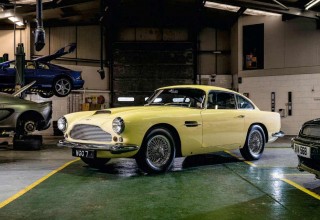
‘I stripped the interior with my son; he’s an apprentice here and it was his first job. The seat frames and springs were OK and the side-hinges could just be sandblasted and rechromed, but the leather was gone completely. Underneath those lime-green seat covers there was evidence of rat infestation. We inched the covers off slowly, and were basically catching chunks of old leather trim and rats’ nest as it fell out, terrified that a rat might still be in there ready to come scurrying out. I’ve still got the vinyl trims actually – they’re in strangely good condition!
‘The door leather was mounted on wooden cards, which had rotted although enough survived to form a template for replacements. It was a similar story with most of the interior. Only the rooflining was standard – fitting a new one was just a case of pulling it across and tucking it in.
‘The rear armrests had completely disintegrated. We ended up taking another DB4 apart to get to another set, mould some replacements in glassfibre, upholster them and fit them to this car.
‘Sadly we also had to fit a new steering wheel, because this one had snapped even before it had started rusting. When people push Astons around they tend to take hold of the wheel to avoid pressing on the soft aluminium bodywork, and end up breaking the spokes.’
Elusive bodywork
Although the fundamentals of the car were coming together nicely, thanks largely to its remarkable originality, Stratton’s parts manager Robert Chapman was hunting frantically for unusual early DB4 parts, working out what could be sourced and what needed to be made from scratch. ‘It was a case of tracking down, ducking, diving and following leads,’ he says.
‘Bumpers are no longer available, and the front one was too rusty to reuse. These early DB4 bumpers were completely smooth-edged, and the only spares available are the types the later cars had, with little flat plinths to screw the numberplates to. So we had to use DB5 bumpers, cut them into three sections, straighten the middle section out, weld them back together and rechrome them – something we had to get done by a firm over the border in Suffolk, because a local health and safety bylaw prohibits the use of the chemicals necessary for rechroming in Norfolk.
‘Sourcing brake parts was hard work, in order to keep them as original. The early DB4 has calipers made of multiple sections, and while we could reuse the outer parts, the main caliper and piston assemblies and the discs themselves needed replacing. We had issues with the front grille too – in the end we had to buy a replacement from Aston at great expense. But the front bodywork was subtly reshaped early on in the DB4 production run, so even this had to be recut to fit. That said, it was a walk in the park compared to so-called ‘logbook restorations’ where basically a new car is created from scratch. At least we had everything to work with as a starting point, which was particularly important because it’s unique – it just didn’t fit!’
It all pays off
‘Usually a DB4 restoration would take us two years – this one took us five,’ says Roger Bennington, whose car now takes pride of place in his personal collection. ‘We thought we had all the time in the world, but we had to rush the last six months because the Aston Martin Owners’ Club found out about it and wanted it for a show. We hadn’t finished the seats, boot floor or engine, so we quickly put the originals back in the car. It still came second in the concours!’
It only comes out on special occasions now, destined to cover minimal mileage and embody the DB4 in its earliest form. ‘I’ll never sell it, I’m honouring the promise I made to Nevill Rees,’ says Bennington. ‘I knew exactly what it was when I first saw the chassis number, and now it’s restored as close to its original form as possible, it deserves to be cherished.’
‘We had to buy a brand-new grille from Aston Martin at great expense – and then cut it up’
MY FAVOURITE TOOL
‘Say hello to Mr Hooky!’ says Paul Bellenger, laughing at it but entirely serious. ‘I can’t get through a day without using Mr Hooky. It’s technically designed for removing old pipework, but it gets used for absolutely everything – shaping bodywork, removing trim, fitting radios, earwax…’
Low point
‘We inched the seat covers off slowly, catching chunks of old leather trim and rats’ nest as it fell out, terrified that a rat might still be in there’
High point
‘There was a little bit of oil left in the engine from 1982, which had kept the internals from corroding.’
Rescued from a Welsh cowshed. Where to start?
Bennington’s team retained as many of the DB4’s pre-production and early-example features as possible – including the rear-hinged bonnet.
Chassis required plenty of new metal, which was let in using rotten sections as a guide.
Leftover engine oil had spared the straight-six’s internals.
Unique AM-logo cam covers were almost beyond saving.
Painting was a protracted process started by one Stratton employee and finished by another.
A new steering wheel had to replace the original item, which had snapped while the car was being pushed.
A rat infestation had taken its toll on the Aston’s interior.
Restored as close to its prototype spec as possible, the DB4 is in now back in the Primrose Yellow it shared with two of its pre-production siblings.





